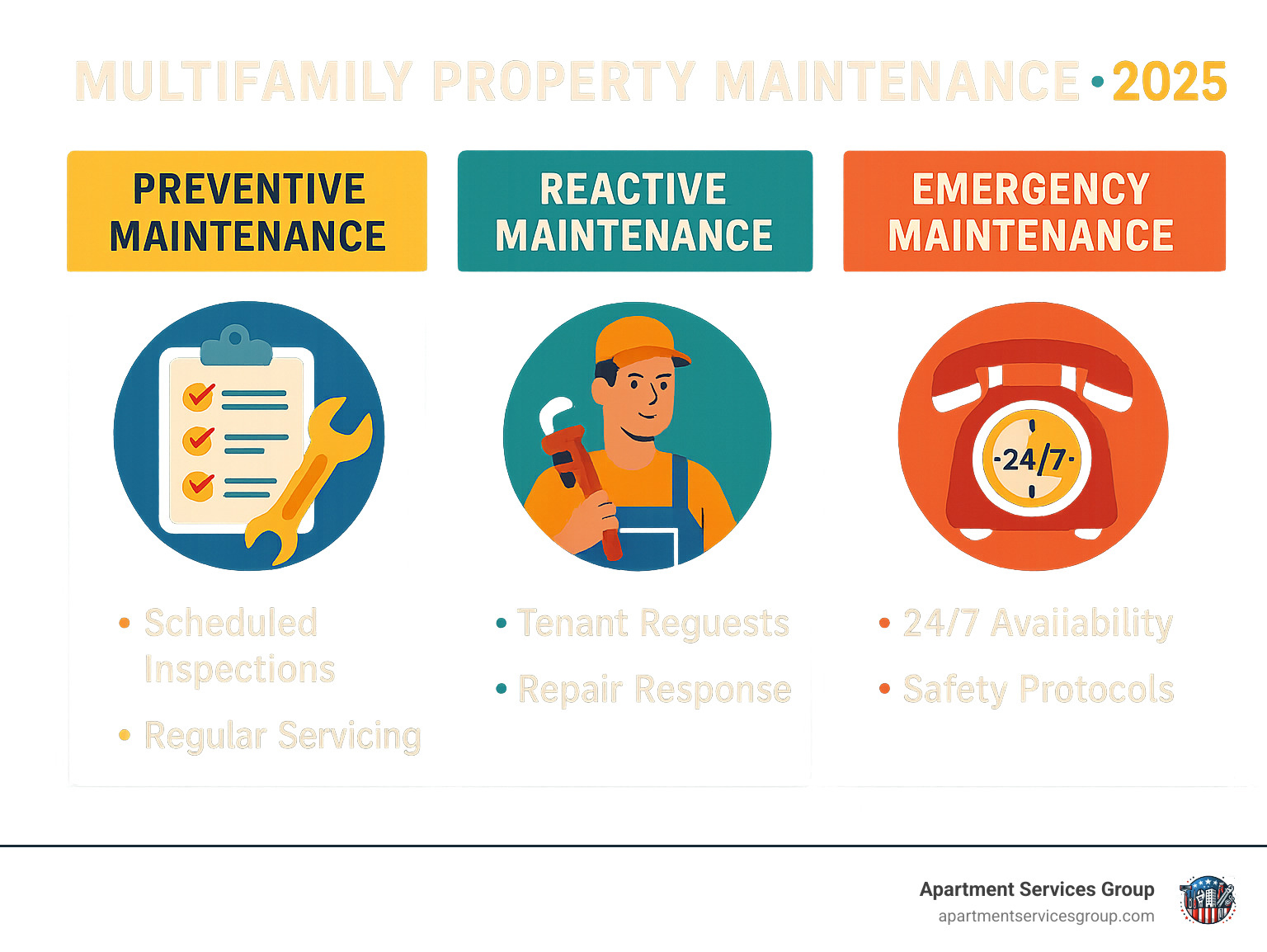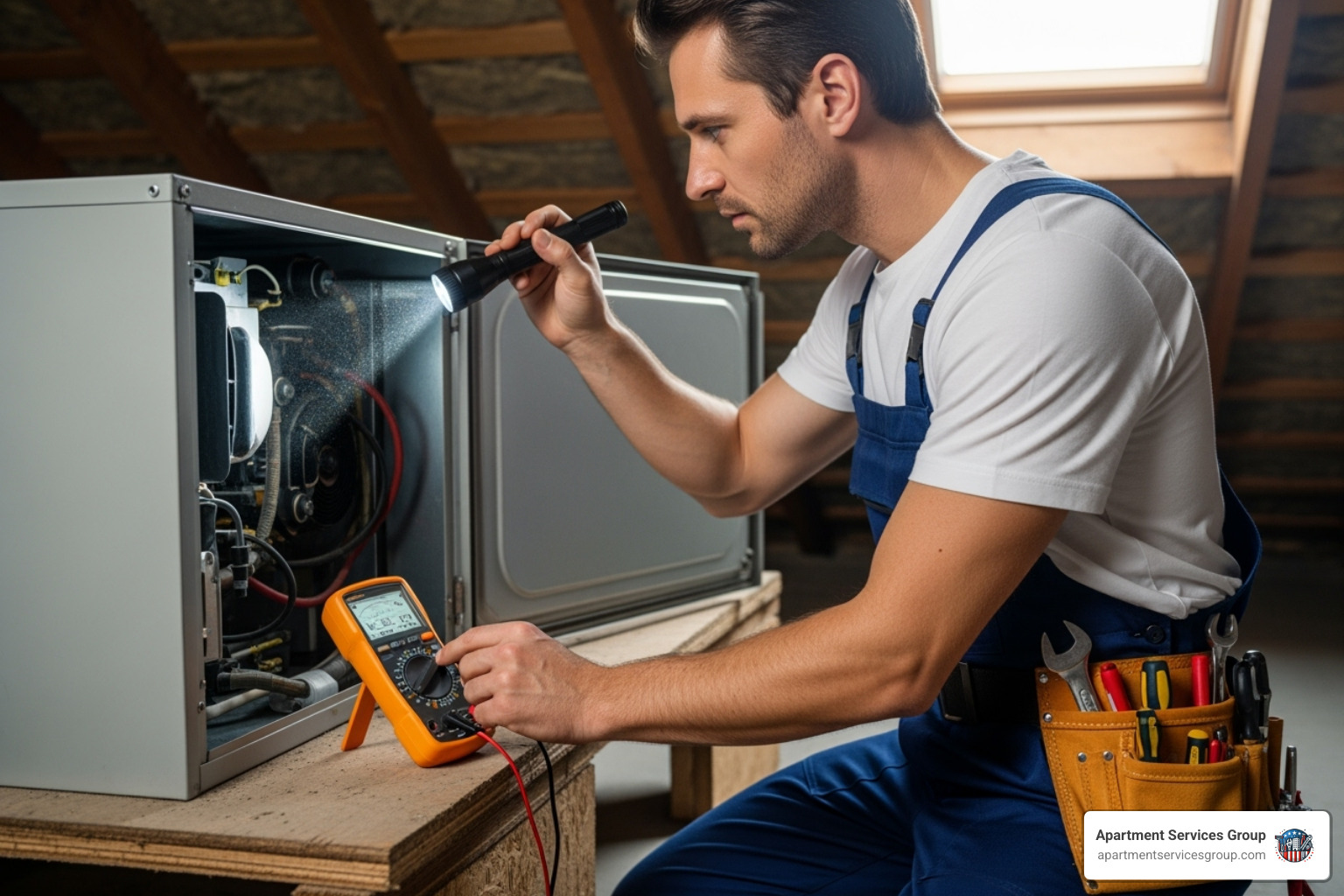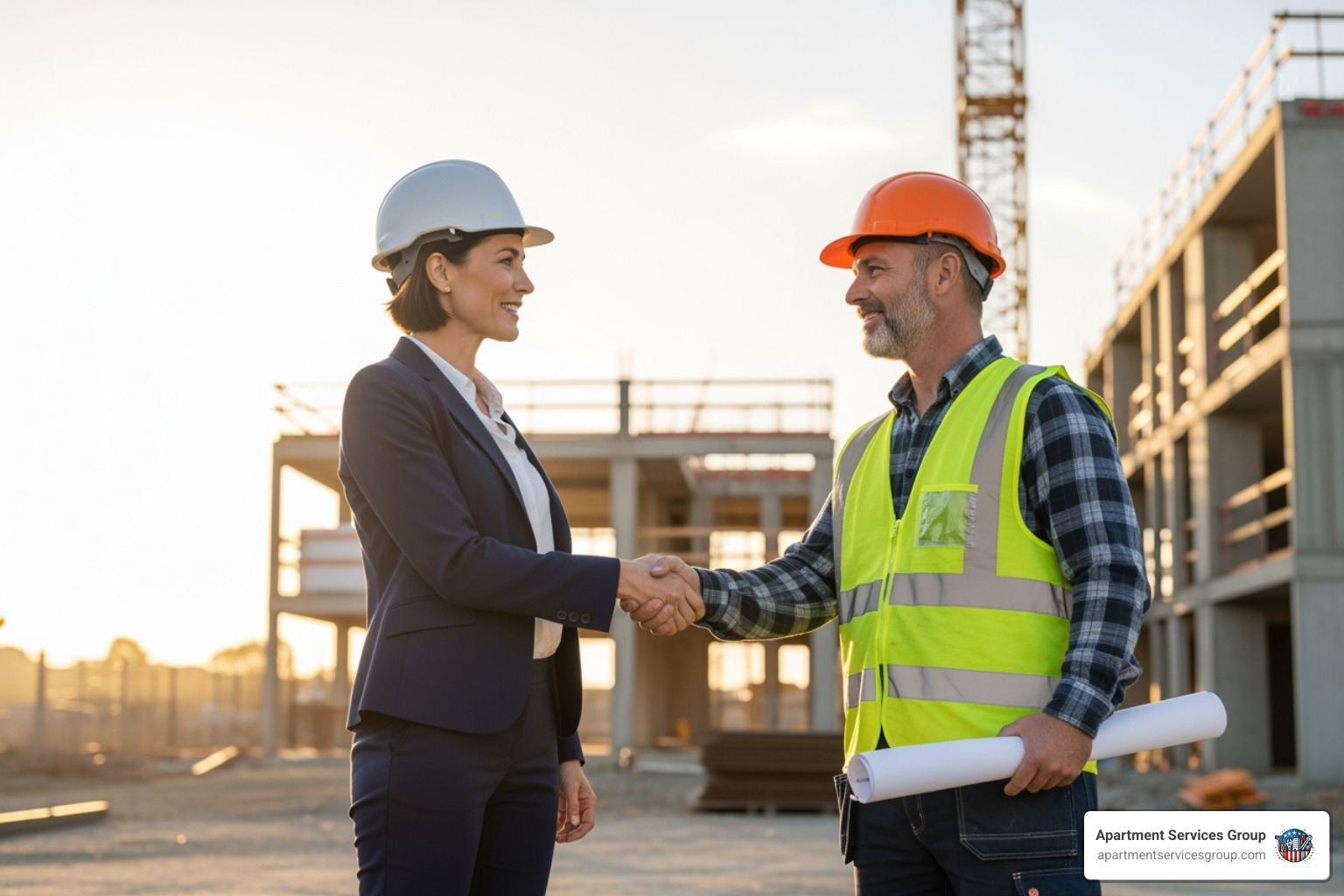Multifamily Property Maintenance: Newbie 2025 Guide
Why Multifamily Property Maintenance Matters More Than You Think
Multifamily property maintenance is the systematic upkeep of multi-unit residential properties to ensure they remain safe, functional, and attractive to tenants. Key components include:
Essential Maintenance Categories:
- Preventive Maintenance – Scheduled tasks to prevent problems (HVAC servicing, roof inspections)
- Reactive Maintenance – Fixing issues as they occur (broken appliances, plumbing leaks)
- Emergency Maintenance – Urgent repairs for safety (gas leaks, electrical failures)
Core Responsibilities:
- HVAC systems and air quality management
- Plumbing and electrical system upkeep
- Structural integrity and safety compliance
- Common area cleaning and landscaping
- Security systems and emergency preparedness
Financial Impact:
- Average annual cost: $1,000-$3,000 per unit
- Preventive maintenance reduces emergency repairs by up to 30%
- Well-maintained properties increase market value by 10-20%
Managing multiple units with shared systems and diverse tenant needs can be overwhelming. Proper maintenance isn’t just reactive; it’s a proactive system that protects your investment and keeps residents happy and safe.
Statistics show that 70% of tenants cite maintenance as a key factor in their satisfaction, and deferred maintenance can cost up to 5 times more than regular upkeep. Understanding the fundamentals of multifamily maintenance is crucial for your success.
I’m Moe Shariff, owner of Apartment Services Group and multiple service companies in Houston with over eight years of experience helping property owners steer the complexities of multifamily property maintenance. Through my work, I’ve seen how the right maintenance approach can transform both your bottom line and tenant relationships.
The Foundation: Core Principles of Multifamily Property Maintenance
Think of multifamily property maintenance like caring for a large, complex home. The foundation of successful property management rests on three core principles: routine inspections, preventive maintenance, and meticulous maintenance logs.
Getting these fundamentals right creates a positive cycle: tenant retention goes up, property longevity increases, and emergency calls become rarer. Happy tenants stay longer, well-maintained systems last longer, and detailed records help you spot patterns before they become problems.
For property owners ready to dive deeper into these strategies, you can find more info about our services and see how we’ve helped hundreds of Houston properties thrive.
The Importance of Proactive Multifamily Property Maintenance
My eight years in this business have taught me one thing: preventing costly repairs is always cheaper than fixing them. Deferred maintenance can cost up to 5 times more than regular upkeep. A small, ignored leak can turn into a burst pipe that floods multiple units, leading to flooring replacement, drywall repair, and displaced tenants.
Extending asset lifespan is where the real money is. Regularly serviced HVAC systems not only last longer but also run more efficiently, lowering utility costs and keeping tenants comfortable.
Most importantly, this approach improves resident satisfaction. When elevators work, hallways are clean, and minor issues are handled proactively, people want to stay. This is why 70% of tenants say maintenance is their top satisfaction factor.
Finally, ensuring compliance is critical. Regular inspections help you catch safety issues before they become legal problems. Working fire safety equipment, code-compliant electrical systems, and safe walkways are legal requirements that protect you and your tenants.
Creating a Seasonal Maintenance Checklist
Smart property managers work with the seasons. A seasonal checklist helps you stay ahead of weather-related issues and keeps your property in peak condition.
- Spring: Focus on recovery and preparation. This includes HVAC cooling system prep, roof inspections after winter weather, and landscaping cleanup to set a positive tone for the year.
- Summer: Prioritize keeping things cool and comfortable. Monitor AC performance, increase pest control efforts, and ensure pool maintenance is consistent.
- Fall: Prepare for colder weather. Schedule heating system checkups, perform gutter cleaning to prevent ice dams, and seal windows to improve energy efficiency.
- Winter: Focus on protection and safety. Insulate pipes to prevent bursting, prepare snow removal equipment and contracts, and stock up on emergency supplies like de-icer.
Treat this checklist as a flexible guide, adapting it to your property’s specific needs and local climate.
Regular Inspections and Detailed Logs
If seasonal maintenance is your strategy, regular inspections are your tactics. They are how you execute your plan and catch problems early.
- Move-in/move-out inspections with detailed photos and notes protect both you and your tenants by documenting a unit’s condition and preventing security deposit disputes.
- Common area checks are vital for first impressions. Regularly inspect high-traffic areas like lobbies, hallways, and laundry rooms for wear and tear.
- Individual unit inspections, when handled professionally, are invaluable for checking plumbing, electrical, and HVAC systems before tenants report a problem.
Documenting repairs in a digital log creates a searchable history for your property. This is crucial for warranty claims, budgeting, and providing records for insurance claims. Your logs should capture dates, issues, actions taken, and costs to help you spot trends and manage more efficiently.
Planning for the Unexpected: Emergencies and Safety
Emergencies are a reality in multifamily property maintenance, but proper planning turns potential disasters into manageable situations. Preparation protects residents, staff, and your investment. Compliance with safety regulations is key to creating a secure home for tenants.
Developing an Emergency Response Plan
A solid plan covers the most common emergencies and ensures a calm, effective response. Key components include:
- Fire: Post clear evacuation routes, train staff on procedures, and regularly test fire alarms and extinguishers.
- Floods: Know all water shut-off locations, have damage mitigation supplies ready, and maintain clear communication with affected residents.
- Power Outages: Prepare emergency lighting protocols and, if applicable, generator procedures. Keep residents informed about restoration times.
- Natural Disasters: For events like hurricanes, secure outdoor furniture, provide residents with safety guidelines, and conduct post-storm property assessments.
For every scenario, maintain updated contact lists and practice your plan with staff. For more details, review Evacuation procedures.
Ensuring Property Safety and Compliance
Safety is woven into our daily multifamily property maintenance routine. It protects residents and ensures regulatory compliance.
- Fire Safety Equipment: Test smoke alarms monthly and replace entire units every 10 years. Inspect fire extinguishers annually to ensure they are charged and functional.
- Electrical Systems: Annual maintenance checks can spot faulty wiring or overloaded circuits, reducing electrical fire risk by as much as 50%.
- Carbon Monoxide Detectors: Treat these with the same care as smoke alarms, with regular testing and battery replacement.
- Walkway and Lighting Safety: Conduct quarterly checks of pathways, stairways, and parking areas to prevent falls and improve security. Poor lighting is a major resident concern.
- ADA Compliance: Regularly assess your property for accessible pathways and common areas. This creates an inclusive community and helps you avoid costly legal action.
Landlords are legally required to maintain habitable conditions. Our commitment to safety protects everyone. For comprehensive security solutions, explore More info about Apartment Security Services.
Assembling Your Team: Managing Vendors and Outsourcing
You can’t handle multifamily property maintenance alone. Success requires a balance of in-house staff and trusted external partners. The key is to vet vendors thoroughly, manage them effectively, and track their performance, as they represent your brand to residents.
Strategies for Managing Contractors
Your contractors are partners in protecting your investment. Managing them well is crucial for smooth operations.
- Thorough Vetting: Always check references from other property managers and review photos of previous work before hiring.
- Licensing and Insurance: Verifying proper licensing and insurance is non-negotiable. It protects your property and residents from liability.
- Clear Written Agreements: Use detailed contracts that spell out the scope of work, timeline, cost, and quality standards to prevent misunderstandings.
- Setting Expectations: From day one, communicate your standards for responsiveness, work quality, and resident interaction.
- Performance Metrics: Track response times, work quality, and resident feedback to identify your most valuable partners.
- Building Relationships: Treat reliable contractors well by paying promptly and communicating clearly. They will prioritize your needs in an emergency.
The Benefits of Outsourcing Maintenance Services
Smart outsourcing can improve your maintenance program while saving money. It’s about working smarter, not harder.
- Access to Specialized Expertise: Professional contractors bring certified experience for complex jobs like commercial HVAC or electrical systems.
- Liability Reduction: When licensed and insured contractors perform high-risk work, much of the liability shifts to them, reducing your exposure.
- Cost Savings: You pay for specialized services only when you need them, avoiding the high overhead costs of full-time employees (salaries, benefits, training, equipment).
- Improved Efficiency: Specialists diagnose and fix issues faster than a generalist, leading to shorter repair times and happier residents.
- Focus on Core Business: Outsourcing allows your property management team to focus on tenant relations, leasing, and strategic improvements.
For properties looking to take their maintenance and improvements to the next level, we also provide comprehensive More info about Apartment Renovation services.
The Bottom Line: Budgeting and Legal Responsibilities
Budgeting and legal compliance are critical parts of multifamily property maintenance. A solid financial plan and adherence to legal standards protect your investment and ensure tenant satisfaction. Maintenance is an investment in your property’s future ROI.
For comprehensive guidance on managing your property effectively, explore More info about Property Management to see how expert management can streamline your operations.
Budgeting for Multifamily Property Maintenance Costs
Maintenance is a significant operating expense, but proper budgeting can boost revenue and reduce large capital expenditures. It’s vital to distinguish between operating expenses (OpEx) for daily upkeep and capital expenditures (CapEx) for major replacements like a new roof.
A common guideline is the 1% rule, setting aside 1% of the property’s value for annual maintenance. However, a more realistic budget is $1,000 to $3,000 per unit annually, depending on the property’s age and amenities.
Always overestimate your maintenance budget for multifamily properties and maintain an emergency fund for unexpected costs. Tracking every expense is crucial for identifying trends and making smart financial decisions.
Understanding Legal and Regulatory Duties
As a landlord, your legal duties are significant. The implied warranty of habitability is the foundation, requiring you to provide a safe, livable environment with functional plumbing, electrical, and heating systems.
You must comply with all local building codes, state, and federal laws, including fire safety standards and regulations like the Fair Housing Act, which requires reasonable accommodations for residents with disabilities.
Finally, you have a legal duty to perform timely repairs once an issue is reported. The urgency depends on the issue’s impact on safety and habitability. Fulfilling these duties protects you from liability and builds positive tenant relationships. To better understand the legal framework, you can Find out more about multifamily properties and their definitions.
Working Smarter: Leveraging Technology in Maintenance
Technology has transformed multifamily property maintenance, replacing paper work orders and phone tag with streamlined digital solutions. Residents can submit requests 24/7, and managers can route them instantly. This automation allows your team to focus on what matters: keeping residents happy and properties running smoothly.
Property Management Software
Property management software is the backbone of modern maintenance. Key features include:
- Automated Work Orders: Instantly generate and assign digital work orders, eliminating confusion and delays.
- Maintenance Request Tracking: Tenants can submit and track requests through an online portal, improving their experience. Digitizing requests can save over 20 hours a month for a 300-unit community.
- Vendor Management: Track contractor performance, schedule appointments, and manage payments in one system.
- Resident Communication: Use portals to send announcements and gather feedback, increasing transparency.
Smart Home Technology and IoT
Smart home technology and IoT devices act as an early warning system, preventing problems and making properties more attractive. These tools can deliver energy savings of 10-20% annually.
- Smart Thermostats: Optimize heating and cooling based on usage patterns, lowering utility bills.
- Smart Locks: Simplify turnovers and improve security by allowing remote access control.
- Leak Detectors: Provide instant alerts for water issues, preventing costly damage from slow leaks or burst pipes.
- Predictive Maintenance Sensors: Monitor equipment like HVAC systems and alert you to potential failures before they happen, minimizing emergency repairs and extending asset life.
This technology helps you work smarter, reduce costs, and create a better living experience. For more tips, check out this 3-Point Rental Property Maintenance Checklist.
Frequently Asked Questions about Multifamily Property Maintenance
After helping hundreds of property owners with multifamily property maintenance, I’ve noticed the same questions come up time and again. Here are the answers to the most common concerns.
What is the difference between routine and preventive maintenance?
Think of it this way: routine maintenance is like brushing your teeth—regular tasks like cleaning gutters or testing alarms to keep things running. Preventive maintenance is like a dental checkup—proactive service, such as an HVAC inspection, to stop problems before they start. Routine maintenance keeps things working; preventive maintenance keeps them from breaking.
What are a landlord’s primary maintenance responsibilities?
A landlord’s primary duties are to provide a safe, habitable home. This includes ensuring functional plumbing, electrical, and heating systems; maintaining the building’s structural integrity; keeping common areas clean and safe; and addressing repair requests in a timely manner.
How does good maintenance impact tenant satisfaction and retention?
Maintenance quality is the number one factor in tenant satisfaction. Prompt, professional service shows residents you care, which leads to higher renewal rates and positive reviews. 70% of tenants cite maintenance as a key factor in their satisfaction. Good maintenance creates a stable, happy community, reducing turnover costs and protecting your income stream.
Conclusion
Managing multifamily property maintenance is achievable with a proactive mindset. Regular inspections, seasonal checklists, and preventive care save money and create desirable communities where people want to live.
Strong tenant communication is key; when residents feel cared for, they stay longer, improving your cash flow and reducing vacancies. Smart financial planning and technology protect your investment, which can increase in market value by 10-20%.
At Apartment Services Group, we’ve spent over eight years helping Houston property owners master these challenges. We understand that your property is more than an investment—it’s someone’s home. We’re here to make your life easier with expert maintenance and management solutions.
Ready to experience the difference that proper multifamily property maintenance can make? Get a Free Quote for your property needs and let’s start building something great together.











